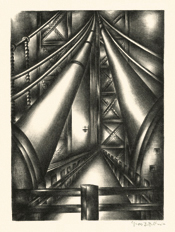|
Jolan
Gross-Bettelheim is known primarily for her powerful modernist graphics
of urban-industrial scenes, and anti-facist imagery created during the
depression and pre-World War II era.
Born in Hungary, in
an area now part of Slovakia, about 1900, she began studying art at the
Academy of Fine Arts in Budapest. She also attended Vienna's Kunstgewerbeschule,
followed by a year at Berlin's Akademie für bildende Kunst. From
1922 to 1924, she was in Paris studing at the conservative École
des Beaux-Arts and at the Grande Chaumière, a private academy school.
Following her 1925
marriage to fellow Hungarian Frigyes Bettelheim, a psychiatrist, she emmigrated
with her husband to Cleveland, Ohio, where she continued her art studies
at the Cleveland Institute of Art. Gross-Bettelheim made her first graphic
work in 1928 and during the next decade regularly exhibited her prints
at the annual exhibitions sponsored by the Cleveland Museum of Art. In
1935-36, she produced twelve prints for the Cleveland-based Graphics Division
of the Works Progress Administration Federal Arts Project relief program.
During this period, she joined the Communist Party, whose advocacy of
workers' rights found a sympathic reception with many social-conscious
artists of the period.
In 1938, the artist
and her husband moved to New York and settled in Jackson Heights, Queens.
Her only American one-woman show, an exhibition of her pastels, was mounted
at the Durand-Ruel Galleries in Manhattan in 1945. The urban
landscape of New York with its monumental buildings and bridges
|
|
became
the subject of her dymanic graphic work during this period. From 1943
to 1950, her work was regularly included in the Library of Congress's
print exhibitions and by 1955 she had made about forty prints, primarily
in drypoint or lithography.
In 1956, her husband's death and the then virulent McCarthyism impelled
Gross-Bettelheim to return permanently to Hungary. She arrived one month
before the Hungarian Revolution, an unsuccessful attempt to overthrow
the Soviet Union's dominance of Hungarian political life. The artist's
pro-Communist views made her an outsider in her native country; she is
said to have lived the remainder of her life in semi-seclusion and she
apparently made no more prints. Gross-Bettelheim died in Budapest at the
age of seventy-two.
Retrospectives of
the artist’s work have been held in Budapest, and Passau, Germany,
in 1988 and 1996, respectively; a small exhibition was also held at Grinnell
College in Iowa in 2001.
Exhibited: CMA, 1928-1937
(prizes); PAFA, 1931, 1933, 1934, 1936, 1941, 1942; AIC, 1932, 1934, 1935,
1937; NAD, 1943-1946; Santa Barbara Mus. A., 1944; LOC, 1943-1944 (prize),
1945 (prize)-1946; Northwest Pr. M., 1945 (prize), 1946 (prize); CAFA,
1944-1945 (prize), 1946; Denver A. Mus., 1944; WMAA, 1942; CGA, 1944;
SFMA, 1944; BM, 1945; Montclair A. Mus., 1945; Durand-Ruel Gal., 1945
(solo); SAGA, 1944-1946, 1950.
|

